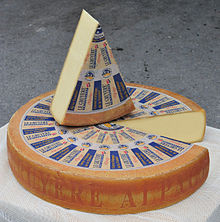
Gruyere cheese

Gruyère (/ɡruːˈjɛər/ or /ɡrɪˈjɛər/; French pronunciation: , German: Greyerzer) is a hard yellow Swiss cheese that originated in the cantons of Fribourg, Vaud, Neuchâtel, Jura, and Berne in Switzerland. It is named after the town of Gruyères. In 2001, Gruyère gained the appellation d'origine contrôlée (AOC, now AOP). Gruyère (/ɡruːˈjɛər/ or /ɡrɪˈjɛər/; French pronunciation: , German: Greyerzer) is a hard yellow Swiss cheese that originated in the cantons of Fribourg, Vaud, Neuchâtel, Jura, and Berne in Switzerland. It is named after the town of Gruyères. In 2001, Gruyère gained the appellation d'origine contrôlée (AOC, now AOP). Gruyère is sweet but slightly salty, with a flavor that varies widely with age. It is often described as creamy and nutty when young, becoming more assertive, earthy, and complex as it matures. When fully aged (five months to a year) it tends to have small cracks that impart a slightly grainy texture. Gruyère cheese is generally known as one of the finest cheeses for baking, having a distinctive but not overpowering taste. In quiche, Gruyère adds savoriness without overshadowing the other ingredients. It is a good melting cheese, particularly suited for fondues, along with Vacherin Fribourgeois and Emmental. It is also traditionally used in French onion soup, as well as in croque-monsieur, a classic French toasted ham and cheese sandwich. Gruyère is also used in chicken and veal cordon bleu. It is a fine table cheese, and when grated, it is often used with salads and pastas. It is used, grated, atop le tourin, a type of garlic soup from France which is served on dried bread. White wines, such as Riesling, pair well with Gruyère. Sparkling cider and Bock beer are also beverage affinities. To make Gruyère, raw milk is heated to 34 °C (93 °F) in a copper vat, and then curdled by the addition of liquid rennet. The curd is cut up into pea sized pieces and stirred, releasing whey. The curd is cooked at 43 °C (109 °F), and raised quickly to 54 °C (129 °F). The whey is strained, and the curds placed into molds to be pressed. After salting in brine and smearing with bacteria, the cheese is ripened for two months at room temperature, generally on wooden boards, turning every couple of days to ensure even moisture distribution. Gruyère can be cured for 3 to 10 months, with long curing producing a cheese of intense flavor. In 2001, Gruyère gained the Appellation d'origine contrôlée status. Since then the production and the maturation is defined in the Swiss law, and all Swiss Gruyère producers must follow these rules. Gruyère-style cheeses are very popular in Greece, where the local varieties are known as γραβιέρα (graviéra). Some Greek gruyères come from San Michálē (Αγίου Μιχάλη, 'St. Michael's') from the island of Syros in the Cyclades, the Naxian varieties, that tend to be milder and more sweet and various graviéras from Crete. Gruyère-style cheeses are also produced in the United States, Wisconsin with the name of Grand Cru, having the largest output. An important and the longest part of the production of the Le Gruyere Switzerland AOC is the affinage (French for maturation).
